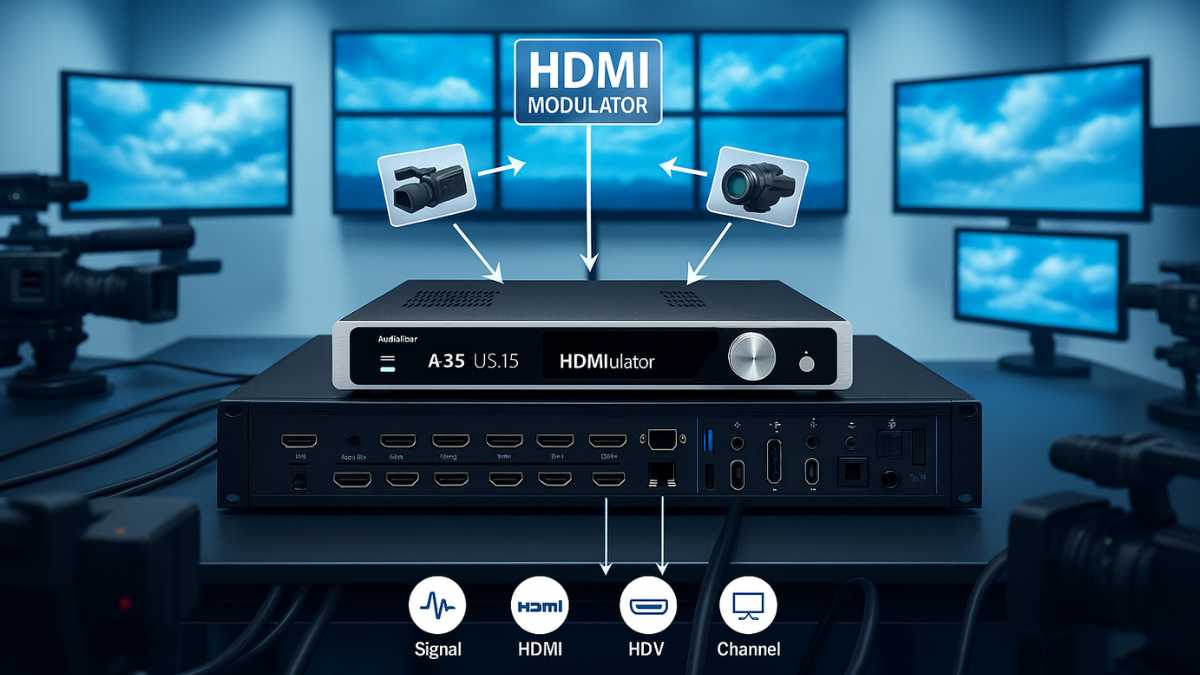HDMI Modulator: The Ultimate Guide to Seamless HDMI Signal Distribution

In the ever-evolving world of digital connectivity, the HDMI Modulator stands out as a game-changing device for both commercial and residential applications. It offers a seamless way to convert HDMI signals into RF signals, allowing high-definition video and audio to be distributed over traditional coaxial networks. This article explores everything you need to know about HDMI modulators, from their functions and benefits to their use cases and how to choose the right one.
What is an HDMI Modulator?
An HDMI modulator is a hardware device that converts an HDMI signal from sources like Blu-ray players, media boxes, or computers into a radio frequency (RF) signal. Once modulated, this signal can be transmitted over coaxial cables and received by multiple TVs or monitors, just like a conventional cable TV channel.
Unlike HDMI splitters that require multiple cables and outputs, HDMI modulators simplify the distribution process by broadcasting the HDMI signal over existing coaxial infrastructure. This makes them a highly efficient solution, especially in buildings where HDMI wiring is impractical or expensive.
How Does an HDMI Modulator Work?
The process involves three key steps:
- Signal Input: The HDMI source device, such as a streaming box or CCTV DVR, sends digital audio and video to the modulator.
- Encoding and Modulation: The modulator encodes the HDMI signal using formats such as MPEG-2 or H.264. It then modulates the signal to a specific RF frequency compatible with your TV system (DVB-T, ATSC, QAM, etc.).
- RF Output: The signal is then sent through coaxial cables to one or more televisions, which receive it as a regular channel.
This process enables long-distance signal distribution without compromising quality.
Key Benefits of HDMI Modulators
1. Versatility and Compatibility
HDMI modulators allow modern HDMI devices to work with older TVs that may not have HDMI ports. This backward compatibility is essential for hotels, schools, and legacy systems.
2. Cost-Effective Distribution
Instead of installing new HDMI wiring or buying additional streaming boxes, you can utilize existing coaxial infrastructure, drastically reducing costs.
3. Centralized Management
You can place all your media sources in one room and distribute content throughout your home or building, creating a centralized control center.
4. Long-Distance Transmission
HDMI signals degrade over long distances, but once modulated into RF, the signal can travel 100 feet or more without loss of quality.
5. Clean Installation
Using coaxial cables that are often already embedded in walls leads to a neater and less intrusive setup.
Where Are HDMI Modulators Used?
Hospitality Industry
Hotels and resorts use HDMI modulators to broadcast content from central sources like set-top boxes or media servers to every room.
Educational Institutions
Schools and universities stream educational videos, lectures, or announcements to multiple classrooms simultaneously.
Sports Bars and Restaurants
They use HDMI RF modulators to display live games or promotional videos on numerous TVs without running HDMI cables to each screen.
Hospitals and Clinics
HDMI modulators distribute health education videos or entertainment channels to patients in different rooms.
Residential Applications
Homeowners can distribute content from a central media room to multiple TVs across the house without needing separate HDMI devices.
HDMI RF Modulators vs. HDMI Splitters
While both devices aim to share HDMI content, they serve different purposes:
- HDMI Splitters duplicate HDMI signals across several HDMI outputs. Useful for short-distance, same-room setups.
- HDMI RF Modulators convert HDMI to RF, allowing long-distance distribution over coaxial cable to multiple TVs on different floors or rooms.
If you need scalable, high-distance coverage, HDMI RF modulators are the superior choice.
Important Specifications to Consider
1. Resolution Support
Many modulators support up to 1080p, and high-end models now offer 4K resolution. Always check what your TVs and source devices can handle.
2. Modulation Standards
Make sure your modulator matches your region’s standard:
- ATSC (U.S., Canada)
- DVB-T (Europe, Australia)
- QAM (Cable systems)
3. Audio Format Compatibility
Check for supported formats like AAC, Dolby Digital, or MPEG Audio. This ensures your audio output works smoothly.
4. Channel Mapping and Naming
Some models allow you to label RF channels (e.g., “Lobby TV” or “Game Feed”) for easier identification.
5. Loop-Through HDMI Output
This feature lets you monitor the HDMI source directly from the modulator itself.
6. IR Remote Pass-Through
Advanced HDMI RF modulators allow remote control of the source device from any room.
Choosing the Right HDMI RF Modulator
To select the best HDMI RF modulator for your needs:
- Determine the Number of Outputs Needed: For multi-TV setups, choose a multi-channel or stackable modulator.
- Match the Modulation Standard: Confirm regional broadcasting requirements.
- Check for 4K or HDR Support: Useful for media centers or luxury hotels.
- Budget and Use Case: Choose industrial-grade models for business use and consumer-grade for homes.
- Ease of Setup: Look for devices with intuitive menus or web-based configuration tools.
Installation Tips
- Use Quality Coaxial Cable: RG6 cables are recommended for minimal signal loss.
- Splitters and Amplifiers: Use RF splitters to branch the signal to multiple TVs. Amplifiers can help in larger installations.
- Grounding and Surge Protection: Especially in commercial setups, always ground your system to prevent electrical damage.
Maintenance and Troubleshooting
- No Signal on TV: Check if the TV is set to the correct channel/frequency.
- Poor Quality: Ensure proper encoding settings; use shorter cable lengths or signal boosters if needed.
- Audio Issues: Match audio output format from your source device with modulator capabilities.
- Firmware Updates: Some modulators receive updates to improve performance. Check the user manual for instructions.
Relative Keywords Usage
If you’re exploring the best options on the market, make sure to search terms like hdmi rf modulator and hdmi rf modulators to compare features, compatibility, and price. These keywords reflect the broad market category for this type of technology.
Conclusion
In conclusion, HDMI modulators are invaluable tools in today’s world of digital media. They provide a smart and efficient solution for distributing high-definition content to multiple displays using the existing coaxial infrastructure. From cost savings and long-range coverage to versatility and reliability, they offer unmatched benefits for various industries and households alike.
Whether you’re upgrading your home entertainment system or managing AV in a commercial facility, investing in the right HDMI modulator will simplify your setup and enhance your viewing experience dramatically.
If you’re serious about modernizing your video distribution, don’t overlook the power of HDMI RF modulators—they could be the missing link to your perfect setup.



